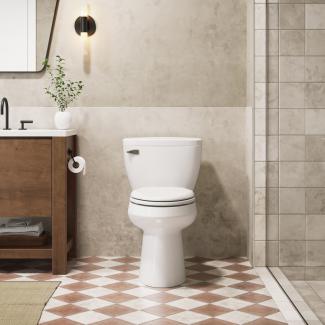
Preparing your Flushmate-equipped toilet for the cold winter months is an essential tactic to prevent components in Flushmate systems from breaking in spaces that may be left vacant for the majority of the winter season.
And while winterizing your Flushmate tank is a quick and easy process, winterizing incorrectly can lead to a damaged Flushmate system.
We recently sat down with Carl Mitchell, Manager, Customer Service at Flushmate, to discuss the proper winterizing method, as well as what to avoid.
Why is winterizing important?
If you own a second home, vacation property, or property only open seasonally that may be vacant for long periods of time, winterizing appliances is essential. In these locations with unheated air space—there’s the possibility that the water line, along with the water inside appliances may freeze and potentially lead to costly damage. Nearly all manufacturers with products working with water will have a winterizing process.
To prevent this, always turn off the water supply to your appliances before leaving for an extended time. For Flushmate-equipped toilets, it’s also crucial to drain the pressure tank. Each unit includes an owner’s manual with quick-reference winterization steps.
The winterizing process for Flushmate systems is simple: turn off the water supply valve and flush the toilet to release pressure. Then, lift the cartridge actuator to drain any remaining water from the Flushmate system into the bowl. Finally, disconnect the water supply line from the lower supply tank, placing a towel or bucket underneath to catch any residual water.
What are some of the primary elements to avoid during the winterizing process?
The most common things we tell customers to avoid is pouring antifreeze into the toilet tank. Introducing any chemicals into the tank with the Flushmate system can damage components and void the warranty. While antifreeze may be suitable to be used with porcelain, the chemicals within antifreeze are not suitable for the internal parts of a Flushmate tank.
We suggest following the porcelain manufacturers recommendations for winterizing the toilet bowl, which may vary by manufacturer, so it’s important to always consult their specific manual. When it comes to the Flushmate systems, we include all necessary steps to winterizing in the Flushmate owner’s manual or on Flushmate’s website.
Do all of your customers know to conduct the winterizing process?
It is included in our manual, so anyone that buys a Flushmate vessel has access to that information. But we do get a lot of calls this time of the year, or even a bit sooner, when people begin to shut down their secondary homes. It’s always our recommendation to winterize your products if you’re not going to be there for an extended period, especially if it’s in a space that is not heated.
How do customers return their toilet to service after the winter?
All the steps regarding winterizing are included in our owner’s manual. When a customer wants to put the toilet back into service we suggest running the supply line into a bucket for 10-15 seconds before reconnecting the water supply. This helps flush out any debris or sediment that may have settled in the pipes while the water was off. Next, inspect the inlet screen and lower supply for any blockages, such as debris. Ensure the screen is clear before reattaching the supply line. Lastly, turn the water back on, allowing the tank to pressurize, fill, and shut off properly. Flush the toilet a few times to clear the bowl. This ensures your toilet is ready for use.